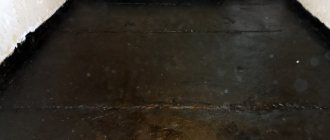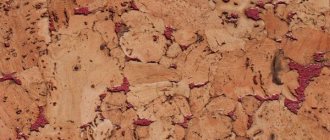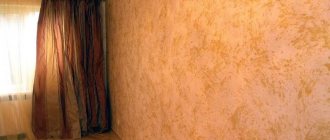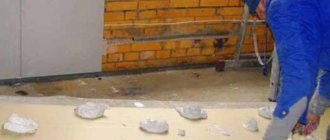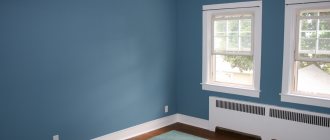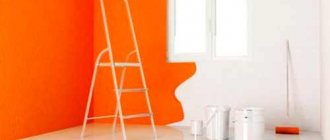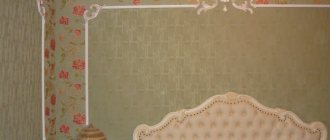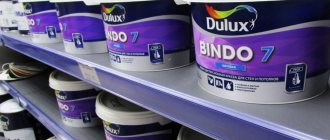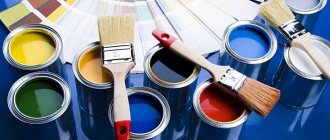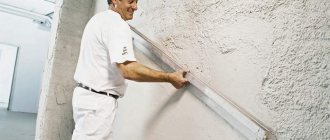The average city dweller is daily exposed to noise that surrounds him at work, on the street, in a city apartment. This contributes to the development of chronic fatigue and leads to serious stressful situations. A person feels the need for comfortable, complete rest after a busy day at work. Soundproofing the walls of your apartment will help you create an oasis of silence at home.
Types of noise and their sources
If the soundproofing of the wall during the construction of the house is done poorly, the residents will experience constant discomfort from the noise occurring in the house. Depending on the physical properties, two types of noise are distinguished:
- Air;
- Structural.
In order to properly soundproof walls in a house, it is necessary to clearly determine the nature of the noise and its sources.
What is airborne noise? These are sound waves resulting from air vibration. Sources of airborne noise include the voice of a person or animal, city transport signals, as well as sounds emitted by musical instruments and equipment.
Structural noise occurs as a result of vibrations of the planes of walls, ceilings, and floors. Energy is transferred from the source to the planes, resulting in the creation of sound vibrations. Sources of structural noise are any mechanical actions aimed at the plane of the floor, ceiling or wall.
Specialized types of sound insulation
There are many types of soundproofing materials. Some of them are used exclusively in construction and decoration, while others are universal.
A separate section is dedicated to car sound insulation. Materials that are used on car bodies can also be used in construction.
For example, automotive vibration dampening mastic is perfect if you need to reduce the volume of a tin roof and corrugated sheet metal shed walls. The mastic is applied using a brush or, if the consistency allows, a spray gun. It dries quickly and dampens noise and vibration quite well.
Another good solution for sound insulation in an apartment, which is borrowed from the automotive world, is vibration-damping materials such as Vibroplast or similar ones. Sheet and roll materials are made on a bitumen basis, akin to Shumaizol or Zvukoisol. An important difference is that Vibroplast is self-adhesive. It is very easy to install - you just need to peel off the protective layer and press the sheet to the insulated surface. A convenient solution for vibration isolation of small areas. For example, this can improve the noise-reducing properties of an entrance or balcony door.
To create a practically soundproof house, it will not be enough to use only one of the materials listed. Each element of the structure will have its own appropriate and effective solutions. It is best if a combination of several materials is used: for vibration absorption, sound insulation and sound absorption.
Types of household noise in apartments
Background noise that negatively affects a person’s psychological state can come from one or more sources. Household noise of various origins brings the most trouble to home dwellers. This:
- Loud conversation behind the wall;
- Sound equipment speakers turned on at full power;
- The heavy steps of an adult or the tramp of children running on the floor above;
- Playing musical instruments;
- Rearranging neighbors' furniture;
- A hammer drill or other working construction tools that are turned on.
Only soundproofing of both internal and external walls in the apartment can save you from excessively noisy neighbors and from external noise, for example, from the work of public transport.
Functional purpose of apartment soundproofing
The reason for the increased background noise in the apartment is poor-quality insulation for walls and ceilings during construction. Properly carried out sound insulation will solve most problems associated with increased noise in a residential area. Therefore, you should not quarrel with your neighbors and sort things out - the smartest thing to do is to soundproof the walls in your apartment yourself.
Thin wall soundproofing with SoundGuard EcoZvukoIzol panels
SoundGuard EcoZvukoIzol panels are a unique material for soundproofing walls and ceilings, which allows you to achieve silence in the apartment without losing useful space.
SoundGuard panels
SoundGuard EcoZvukoIzol panels are made of durable multi-layer cardboard profiles based on the honeycomb principle, which are filled with thermally treated mineral quartz sand. The quartz filler used is very fine, exactly the same as an hourglass. It is this filler that makes it possible to achieve an impressive weight of the panel - more than 18 kg per m2, and according to the laws of sound insulation, the heavier the material, the worse it transmits sound (cotton wool transmits sound very well, but for example, a brick wall or a steel door is much worse). In addition to its weight, quartz sand, due to its fine fraction, perfectly dampens and absorbs almost all frequencies of sound - from airborne to shock.
How to install SoundGuard EcoZvukoIzol panels ?
Installation of the panels is very simple and almost anyone can handle it. Soundproofing panels are attached to the wall using SoundGuard DAP acoustic anchors, which are driven into pre-drilled holes through the panel in the wall. After this, all seams and joints are coated with sealant and the entire wall is covered with plasterboard.
Soundproofing methods
The use of modern technologies and building materials allows the use of four methods of soundproofing residential premises:
- Decoupling is an effective method during construction or major renovations. Based on the principle of transmission of vibration or sound through building structures. In panel construction, different sets of beam fastening studs are used for two adjacent wall panels - this prevents the spread of vibration between them. A house that was built using one set of studs for two adjacent panels should use vibration decouplers. True, this is complicated by the need to dismantle old walls, floors and ceilings. Therefore, this method is not used for DIY soundproofing of walls.
- Absorption method. In the hollow walls of modern buildings there is air, which perfectly transfers vibrations from one wall surface to another according to the drum principle. This can be avoided by using sound-absorbing materials. In addition to sound insulation, they create an additional thermal effect, since sound energy is converted to a small extent into heat. The degree of absorption of sound energy depends on the thickness of the layer of material used.
When thermal insulation and waterproofing of external walls and ceilings is carried out, a significant soundproofing effect is also achieved.
- Increasing the mass of the wall. Based on the principle of dependence of soundproofing properties on the density of the material used. The thicker and heavier the material used on the wall, the more sound insulating it will be. This method is most effective for isolating airborne noise, but will not eliminate noise that has a structural source.
- The attenuation method is the most effective of all methods used to soundproof walls with your own hands. The combination of sound-absorbing and vibration-insulating materials makes it possible to abruptly stop sound and convert sound energy into heat. This method allows you to limit the penetration into the apartment of low-frequency noise that is of a structural nature and arises as a result of impacts, the operation of electrical tools or construction equipment.
Criteria for choosing sound insulation for an apartment (house)
Type of noise . Oddly enough, this criterion is the most important. There are the following noises: airborne (sounds coming from outside through the air - enterprises, highways, music); impact (this includes working with nails and other building materials); structural (vibration from cars, transmitted into the room and converted into decibels).
Dimensions of the room . If sound insulation is installed in only one small room, then a regular sheet of drywall will do, which will not reduce its area in any way. For large rooms, multilayer structures will be required that take up additional space (kraft cardboard, styrene).
Purpose of the room. When purchasing materials for sound insulation, it is important to pay attention to the label, which must indicate for which room this product is intended.
Types of soundproofing materials
It is no coincidence that we paid considerable attention to the physical nature of noise and methods of sound insulation - in each specific case a certain type of sound insulation is used, taking into account the qualitative characteristics of the material used.
There are main types of sound insulators:
- Special. They are used to create acoustic effects in a room, mainly used in theaters, cinemas, and recording studios;
- Materials for protection against airborne noise;
- Vibration noise insulators.
To soundproof a wall in an apartment or your own house with your own hands, the last two groups of materials are used. They allow you to isolate your home from noise from the street or from disturbing neighbors.
Modern soundproofing materials often have a combined nature and protect simultaneously from airborne and structural noise. However, one should not discount the need to provide reliable sound protection to special risk areas - window and door openings.
Important point
When choosing materials for soundproofing walls in an apartment with your own hands, a significant mistake is often made when a person confuses the concepts of sound insulation and sound absorption. It is important to note that these are two completely different concepts.
Sound-absorbing materials do not have a soundproofing effect, although they are an integral component when carrying out soundproofing work. The bulk of sound-absorbing materials transmit sound, while improving the acoustic characteristics of the room. They are suitable for rooms equipped with sound sources to eliminate echo effects.
In order to provide effective sound insulation from external sources, sound-absorbing materials are not suitable - this requires insulating materials that protect against noise and ringing.
There are two types of soundproofing materials:
Soft insulation
This type includes roll-type insulating materials made from various fibers. These include:
- Self-adhesive or conventional soundproofing membranes made from fibers of natural or synthetic origin. The most popular type of soft insulation today is Texaund - an ultra-thin heavy membrane based on the natural mineral aragonite and binding polymers. This material, due to its elasticity, fire resistance and high sound insulation qualities, has given a new direction in the process of sound insulation.
- Fiberglass (glass wool), mineral wool. It is used to insulate walls and ceilings, including frame structures, but requires additional external protection. Available and relatively cheap material.
- Polyester fabric. It is used as a substrate for laminate flooring and has good soundproofing properties.
Solid insulation
This type of insulation includes slabs or panels made from soundproofing materials:
- Foam boards. They are the most common cheap soundproofing material. The best option for those who want to soundproof a wall from neighbors without significant costs.
- Combined panels. Construction made of chipboard sheets, synthetic materials or cork with a layer of mineral wool or quartz sand.
- Basalt fiber slabs. Reliable soundproofing material, which can additionally be treated with moisture-repellent compounds.
- Synthetic boards. Made from polyester fibers. Thanks to their easy cutting, they are popular in the construction of frame housing.
- Fiberglass boards. They are made using the staple weaving method, which enhances their sound-absorbing properties. They are used as an insulating material in frame construction and for suspended ceilings.
- Cork slabs. One of the most expensive soundproofing materials, made from natural balsa fiber. They are distinguished by their environmental friendliness and high soundproofing ability.
Materials for frame sound insulation
Frame sound insulation is more complex and several times more expensive than its cheaper competitor, but it protects the space from vibration and noise 2.5 times better.
Conditions for correct installation:
- High-quality vibration suspensions.
- Rigid profiles for creating a frame.
- Thick layer of soundproofing filler.
- High-quality vibration-absorbing drywall.
- Sealant.
- If necessary: soundproofing boxes for sockets.
And now, in order:
- Vibrating suspensions are a fastening element for a frame structure. They are U-shaped mounts, on top of which a vibration-absorbing element is installed. It allows you to firmly attach to the wall and transmit vibrations to the sound-absorbing structure. The main indicator of a high-quality vibration suspension is the possibility of rigid fastening with 2+ screws and a high durability life. A popular model is Vibroflex-connect PS and its varieties.
- Profiles are p or w-shaped strips made of strong metal, which are installed on vibration suspensions in a regular grid (where the horizontal or vertical edge of the square is equal to the edge of the sound insulation square). Serves as a basis for attaching drywall. High-quality profiles - Vibronet-profile and VIBROFLEX-Wave. Please note that the mount must be purchased additionally.
- Soundproofing material - glass slabs or mineral wool in regular parallelepipeds, up to 15 cm thick. Placed in the grooves of the frame, with the front side facing the wall. They are pressed against sound-absorbing plasterboard. Popular models are AkuLight NEO, Shumanet SK-Neo, Shumanet-BM.
- Vibration-absorbing plasterboard - sheets of a special composition, up to 3 cm thick. They are used as a finishing layer of sound insulation and the basis for cosmetic repairs. High-quality sheets are dense and durable, able to withstand severe dynamic loads. For the above materials, sheets produced by Aku-Line GLKA, Soundline-dB and related ones are suitable.
- It is better to use two products as a sealant: thin self-adhesive tape, 10-15 cm thick (Vibrostek M-100), and liquid silicone compound (Akuflex-VS and others).
The total cost of 1 m² of frame sound insulation will cost you 4000-7000 rubles, including installation, but excluding cosmetic repairs.
How to soundproof a wall in an apartment
If you need to isolate one wall from its neighbors, you can use several of the simplest methods:
Handy sound insulation
This is the simplest and cheapest way to protect yourself from street noise or overly noisy neighbors. You can use ordinary interior items to reduce the noise level by 20–30%:
- Thick curtains on the windows muffle street sounds made by city transport.
- A rug hung on the wall creates the same effect. It perfectly absorbs sounds from the outside - be it the street or noise in a neighboring apartment.
- If you put a carpet on the floor, it will significantly reduce the outgoing noise when moving around the apartment.
- A furniture wall placed along a common wall with them will help get rid of the penetrating noise from the neighboring apartment.
Plasterboard sound curtain
Plasterboard sheets are a universal material that allows you to make a soundproof partition in a room, as well as provide reliable sound insulation from the outside. The sound insulation properties of a gypsum plasterboard partition mounted on two independent frames are higher than partitions made of the same material, but mounted on one frame. The first option is suitable for sound insulation without additional insulation.
In the second option, to increase sound insulation, it is recommended to use two sheets of plasterboard with an intermediate layer of viscoelastic materials, as well as subsequent cladding of gypsum boards with sheets of fiberboard, gypsum fiber board and analogues with less rigidity. To reduce the transmission of vibrations, it is necessary to reduce the rigidity of the connections between the frame structure and the cladding - elastic gaskets are used at the fastening points.
The video below shows the features of soundproofing walls in an apartment:
Gluing sound insulation to the wall is as easy as shelling pears and cheaper than cheap
The easiest and simplest option for soundproofing an apartment is gluing soundproofing roll materials to the walls and ceiling. They are easy to cut and fit well on the prepared surface. Despite the higher cost of the material itself compared to drywall, roll sound insulation can be applied independently without additional costs.
The process of laying soft sound insulation itself does not require additional knowledge and skills. It is suitable for almost all owners of city apartments who want to save time and money when carrying out work themselves. As an option for light sound insulation, you can use wallpaper based on artificial velor - in this way, the decorative decoration of the walls will simultaneously serve as additional sound insulation.
We have given several ways in which you can reduce the noise level in a city apartment. Which one is preferable must be decided in each individual case, taking into account financial capabilities and the expected effect.
System design
Photo: Panels for frameless sound insulation of walls.
Author: Roman Rybkin To reduce the ability to transmit extraneous sounds into the room, a special slab design is created, in the middle of which there is a soundproofing layer. As a rule, sound insulation and plasterboard sheets are used to make such a slab. To fix the structure to the wall surface, special acoustic dowels are used that do not allow noise to pass through. The panel is installed in pre-prepared grooves, which greatly simplifies the work and provides effective protection against sound penetration. If there are gaps in the structure, it is advisable to seal them with a special soundproofing tape, which today can be purchased at any hardware store or supermarket.
Depending on the needs of the apartment owner, the thickness of such a system can vary from two to twelve centimeters. Frameless sound insulation of walls can reduce the noise level in an apartment by 45 dB. To put the numbers into perspective, loud talking equates to 55dB. Therefore, if sound insulation reduces the noise level by 45 units, then there will be absolutely no residual sound.
Photo: Wall cladding to improve sound insulation. Author: Roman Rybkin
It is important to know that the quality of sound insulation and its functionality directly depends on the quality of the preparatory work and the materials used. It is very important to carefully approach the preparation of surfaces and the choice of material.
Soundproofing walls in an apartment
Continuous noise accompanies city residents throughout the day and even night. The problem of protection from various sounds from neighboring apartments, cars on the street, music, and televisions has now become of great relevance.
Modern materials for soundproofing walls in an apartment can solve this problem and make a person’s life comfortable and calm.
Usually one material is not enough for complete sound insulation, so it is advisable to use several different methods, materials of different compositions and thicknesses.
Soundproofing KNAUF
Soundproofing materials from the German concern KNAUF, like all building materials of this brand, belong to the professional class of products and are distinguished by unsurpassed quality and unique parameters. The company offers modern materials for soundproofing walls in an apartment or house, which are easy to install and durable.
New AcoustiKNAUF
The KNAUF product range includes several types of soundproofing materials, one of the most popular of which is New AcoustiKNAUF.
This is an innovative material that surpasses previously used ones in terms of rigidity, elasticity and the ability to restore shape after mechanical deformation. Elasticity allows the material to densely fill the openings of the frame and remain there during vibrations or shock loads on walls and partitions during installation and further operation.
The main material is mineral fibers, bonded with environmentally friendly binders using ECOSE technology. Formaldehyde and phenols are not used in the production of AcoustiKNAUF New. According to environmental indicators, the sound insulator is approved without restrictions for use in residential buildings and apartments, children's and medical institutions, and public places. It does not generate dust, does not emit odors or toxic substances in any operating mode, and is non-allergenic.
Technical characteristics of the New AcoustiKNAUF
| Sheet dimensions, mm | 2130x610x50 |
| Sheet area, m2 | 0,75 |
| Flammability group | NG |
| Noise reduction level, dB | Up to 57 |
| Density, kg/m3 | 15,5 |
The material is used to create a soundproofing gasket in a complex multi-layer finish in combination with gypsum plasterboard or gypsum fiber board. Installed for interior finishing of walls, ceilings, partitions. Installation in hollow structures under a rigid base along a frame is possible.
Knauf Insulation Acoustic Partition
Another product of the concern from Germany is no less in demand - KNAUF Insulation Acoustic Partition. Created on the basis of mineral wool, it performs both soundproofing and thermal insulation functions. It is produced in the form of slabs or mats, characterized by a high level of elasticity. Used in dry finishing systems for walls and floors in residential and industrial construction. It features active sound absorption and vibration protection.
In the audio range 125 – 4000 Hz, the noise absorption coefficient is 0.56 – 1, which allows reducing the overall sound background by 30 – 40 dB. Thin fibers (no more than 3 - 5 microns) in the form of long threads (up to 150 mm) provide active resistance to the propagation of sound waves and absorb their energy at all frequencies. The large sizes of slabs and rolls make it possible to minimize the number of joints, which has a positive effect on the level of noise insulation and thermal protection.
Technical characteristics of Knauf Insulation Acoustic Partition
| Slab dimensions, mm | 1250x610x50 |
| Roll dimensions, mm | 7500x610x50 |
| Sound absorption coefficient (50 mm) | 0,25 – 0,94 |
| Noise reduction level, dB | 30 — 40 |
| Slab area, m2 | 0,76 |
| Mat area, m2 | 4,575 |
KNAUF Insulation is used in frame systems of walls and partitions in all types of residential and industrial construction, and is actively used in suspended ceiling and floor systems with any type of coating.
How to choose the best sound insulator
Before choosing such a material, you should determine what type of noise needs to be eliminated. The main types of noise in modern apartments include:
- Drums. Sound waves penetrating through solid materials of ceilings and walls. For example, the noise of a hammer drill, impacts, steps.
- Airborne. They enter the house through the air, for example, the noise of cars on the street, conversations, the sounds of TV, music.
- Structure noise. They combine the properties of percussion and air.
Each type of noise requires the use of different materials and sound insulation methods.
Airborne noise control materials
To eliminate airborne noise, porous soundproofing materials for walls are required, since the sound wave is scattered through the pores and openings, although the noise is not completely absorbed.
Therefore, the function of insulating airborne noise is assigned to the supporting structures of buildings. In addition to monolithic walls, metal or wooden beams are used, between the layers of which sand, expanded clay, and other bulk materials are poured.
It is effective to use liquid materials that contain vacuum elements: cork, glass and mineral wool, rubber, fiberglass.
Impact sound insulation
To protect against impact noise, shock absorption and vibration-absorbing materials are used. Impact noise is 20 dB stronger than air noise, so materials for soundproofing walls combine the properties of absorbing vibration and dissipating sound.
When constructing a building frame for sound insulation, it is necessary to make massive floors, which is quite labor-intensive and expensive.
It is effective to use special floor designs, for example, floating. Special insulating pads are placed under the coating for sound absorption. Additionally, carpets and coverings with a foam base are used.
Impact noise insulation products:
- Acoustic slabs Shumostop (20 mm), which consist of two slabs: fiberglass and basalt.
- Thin roll slabs Schumanet 100 Combi (5 mm) for laying under screed.
How to make sound insulation with your own hands
If the apartment is located in a high-noise area, then additional soundproofing materials are essential. The following panels can be installed independently:
- ZIPS (soundproof sandwich panels).
- Decorative, filled with bulk materials.
- Made from wood fiber or compressed cork chips. Provide protection from vibration and impact noise. They are used for soundproofing walls in houses located near noisy objects: highways, factories, warehouses.
- Polyethylene foam, elastomeric plates. They are rarely used due to their high flammability and fragility, although they have good sound insulation properties.
- Expanded polystyrene. Suitable for eliminating structural noise. It has vibration-absorbing, noise-absorbing properties, as well as high thermal insulation. Disadvantages: high flammability, significant reduction in room area.
High-density thin materials for sound insulation:
- Liquid. When using them, the area of the room is not reduced, no preliminary preparation is required, and complete sealing is possible.
- Fiberglass, randomly laid glass threads. Perfectly protects against sounds and vibrations. It is used for pasting the joints of slabs, other structural elements, as well as walls.
- Wallpaper backing (for example, polyethylene). Perfect alignment of the walls in the apartment with putty is not required. The substrate itself will hide imperfections and irregularities.
Polyethylene is covered with paper on both sides and assembled into a roll. Therefore, it is enough to cut this material into pieces of any size and then glue it without overlap.
A mandatory requirement is to maintain the room temperature at least 10. After complete drying, you need to cover the room with any wallpaper. The substrate has water-repellent properties, so you can paint the wallpaper with water-based paint.
Preparatory work
If you decide to soundproof the walls in your own apartment, then it is combined with the renovation of the apartment. Preparatory work begins with sealing the cracks and joints between the slabs.
If the cracks are small, you need to carefully putty them. Large ones are filled with polyurethane foam or just rags. The rags must be compacted thoroughly.
An important point in the work is getting rid of through sockets, for which you will have to change the electrical wiring, and all other sockets must be carefully secured in their sockets.
A thick layer of high-quality elastic plaster, in combination with putty, provides a good level of sound insulation of the walls in the apartment. That is, ordinary noise from neighboring apartments, without shouting and loud music, can be neutralized.
Types of modern materials for soundproofing apartment walls
Walls and ceilings are faced with frame and frameless systems, which are highly effective with accurate calculations of design parameters and correct installation.
In cases where there are even slight doubts about one’s abilities, specialists should be invited to ensure that no violations of technology are committed.
The difference between frame and frameless systems is only in the installation features. Frameless ones are suitable for self-installation due to the fact that they are easy to install and the likelihood of errors during installation is also low.
ZIPS refers to frameless systems. This is a sandwich panel, the thickness of which varies from 40 to 120 mm. First, this panel is mounted on the wall and then covered with weighted plasterboard (12.5 mm).
Over the past two decades, this system has proven its highest efficiency. The third generation ZIPS-111 Ultra (55 mm) has already been released. The additional noise insulation index is 11−13 dB.
Frame structures, at first glance, are similar to standard cladding and suspended ceilings. In fact, they consist of general building elements and a set of acoustic elements with a noise insulation level of 2-5 dB each.
When using frame structures, simultaneously with the installation of sound insulation, the surface of the walls and ceiling is leveled.
The best soundproofing mineral boards
These slabs are most often made on the basis of basalt wool, which, in addition to soundproofing properties, also has good thermal conductivity. It absorbs noise in the frequency range 125-4000 Hz with a coefficient close to unity. The latter indicator is influenced by the thickness and tightness of their fit to the wall or floor. After studying the characteristics of 7 options, we settled on the 2 best materials for sound insulation.
Schumanet BM
The Schumanet BM mineral board is created on a basalt base, which gives building materials strong sound-absorbing properties. Its high acoustic quality was ensured by its good density (40 kg/m3), the absence of pores as such, and a thickness of 5 cm. However, precisely because of the latter indicator, this product is not very relevant for small rooms where every centimeter of space is valuable. The package contains 4 sheets with dimensions of 1200x600, which, on the one hand, is convenient for installation, and on the other hand, speeds up the process.
Schumanet BM is made of non-flammable materials, and therefore resistant to high temperatures and fireproof. It also serves for quite a long time due to its reliable resistance to moisture, rotting, and microbes thanks to high-quality hydrophobic treatment. Low specific gravity (47 kg/m3) prevents the product from overloading supporting structures and allows installation without the use of special equipment. It is actively used both for cladding walls and ceilings, and for filling voids between main structures.
Advantages
- Suitable for both industrial and residential premises;
- Easy installation;
- No unpleasant smell;
- Noise absorption coefficient NRC – 0.9;
- Total weight – 5.75 kg;
- Smooth surface.
Flaws
- The aesthetics of the appearance leaves much to be desired.
SoundGuard EcoAcoustic 80
This is a more expensive option compared to the previous one, but according to reviews, its quality is slightly higher. The plate is environmentally friendly and safe, as it is made only from acrylic binder and mineral fiber. These sheets are designed for soundproofing ceilings and walls, which they do well due to their density of 75 kg/m3. During installation, dust does not appear and the workspace remains clean, and there is no harm to health, since no hazardous substances are released.
Since this acoustic system does not contain formaldehyde or other aggressive additives, it can be safely used for finishing walls and ceilings in residential premises, including children’s rooms where an allergic child lives. This stove is also relevant in recording studios, listening rooms and cinemas with several halls to eliminate extraneous noise. Its important feature is the absence of chips during installation due to its good strength. Installation is also made easier by laying the slabs spaced between the posts, which does not require fasteners.
Advantages
- The highest sound insulation class is A;
- Fire safety;
- Resistance to high humidity;
- Has thermal insulation properties;
- Does not shrink over time;
- Does not give off an unpleasant odor.
Flaws
- Nondescript color.
The set comes with 4 or 10 slabs to choose from; if you buy more, you can save a little. With this volume it is possible to cover an area of 3 square meters. m. Sheets of two thicknesses are also available for sale - 20 and 50 mm.
Features of choosing thin sound insulation
Thin soundproofing materials do not hide much useful space in the room, so when choosing a material you should pay attention to them.
Types of thin materials:
- Soft. Efficiency is 95%. These include mineral wool. For high sound insulation, a layer 50 mm thick is sufficient, although the wool is covered with sheets of plasterboard and metal profiles, which makes the structure thicker.
- Semi-rigid. They consist of soft materials, but pressed into hard slabs. Effect up to 70%. A layer of material less than 50 mm is used.
- Tough. Low noise insulation (less than 50%), but great thinness, which is important for small apartments.
Thin materials include:
- Sound block or loaded vinyl. Despite the extremely small thickness (2 mm), it is very heavy, since it contains aragonite and mineral barite in the form of small particles.
- Foamed polyethylene covered with two layers of paper on both sides. It has extremely little sound insulation, that is, it cannot protect against sound above a whisper. Used as a complement to other materials.
- Cork. Natural material 30-50 mm thick, beautiful appearance, increased ability to absorb noise and sounds. It is used simultaneously as a decorative element and a sound absorber.
- Panels Von Star (Germany). They are reminiscent of drywall, but much heavier. The sheet weighs 20 kg, inside the panel there is a filler that absorbs noise.
- Tecsound membranes also consist of aragonite with the addition of polymers. They have a thickness of 3.5 mm and increased flexibility. Safe in terms of ecology and fire.
The use of Texaund for sound insulation allows you to achieve the desired effect without increasing the thickness of the entire system. The special membrane Texaund SY with a self-adhesive base is considered to be of especially high quality.
Used in frame and frameless building structures.
The best soundproofing plaster
Dry mixtures for creating a soundproofing layer are made on the basis of gypsum, cement, lime and other binders. They cover both the entire wall and only some part of it, for example, filling voids. Due to this, extraneous noise does not penetrate into the room. It is environmentally friendly and resistant to long-term exposure to negative environmental factors. This is exactly what the material presented in this category is like.
U-Stucco RDX
U-Stucco RDX plaster is intended for interior work and creating a single-layer wall covering. The latter saves time and labor costs. It has pronounced soundproofing properties and weighs much less than ordinary plaster. They can process a variety of surfaces - foam concrete, brick, wood and even metal.
The product is highly environmentally friendly, being almost half made from recycled materials. The safety of its use is ensured by its high resistance to heat and open fire; it does not melt or ignite. When applied correctly, it does not interfere with the walls’ ability to “breathe” normally and prevents the appearance of dampness and mold in the room.
Advantages
- Economical consumption - approximately 3 kg per wall with a layer 10 mm thick and an area of up to 1 sq. m.;
- Sold in packs of 20 kg;
- Homogeneous texture;
- Does not require thorough mixing when preparing the working mixture;
- Over time, sound insulation properties do not deteriorate.
Flaws
- Not low cost;
- Cardboard packaging may become wet if exposed to high humidity.
Reviews note that if the walls are very rough, consumption increases by 10-20%.
The best soundproofing membranes
This material is flexible sheets, rolled into rolls, with a thickness of 3.7 mm. They are actively used in both industrial and residential facilities and are suitable for creating a soundproofing layer on walls, floors, and ceilings. Their installation does not require expensive equipment or special tools. Of all the options offered on the market, two membranes with the best characteristics deserve special attention: high density, good sound absorption, etc.
Soundguard
This product is universal and widely used for sound insulation in both residential and commercial premises: offices, production workshops, etc. According to reviews, the desired effect is pronounced, which was made possible due to the thickness of 3.7 mm and low porosity. This membrane serves as a substrate for preparing the final coating and is effective when laying floating screeds on the floor.
The Soundguard membrane has found application in both framed and frameless structures. It is compatible with gypsum fiberboard, gypsum board, oriented strand board, plywood, etc. This material for soundproofing walls is ultra-thin; the sheet thickness is no more than 2 mm, which does not significantly affect the height of the ceilings.
Advantages
- RW – 27 dB;
- Supplied in rolls of 3 sq. m.;
- Good flexibility for easy styling;
- It stretches without problems, but does not tear;
- Can be laid in both horizontal and vertical planes.
Flaws
- The roll weighs 12 kg.
My personal experience of using Soundguard has shown that this membrane is not afraid of exposure to high and low temperatures, can easily withstand temperature changes and excessive humidity, is not susceptible to the formation of mold and mildew, and does not begin to rot over time. Therefore, it can be safely used both in subtropical climates and in conditions of frequent cold weather.
Tecsound
Texaund is a self-adhesive membrane with a small thickness and good elasticity. It is made on the basis of natural components - the mineral aragonite and binding polymers. Thanks to this, the product is quite flexible with a thickness of at least 4 mm, which makes installation easier, but at the same time increases service life. This is a universal product suitable for sound insulation of gypsum fiber, plasterboard, glass magnesium, plywood and other coatings.
The sound insulation index is 28 dB, which ensures a comfortable stay in the room. The material is certified according to quality standards accepted in Europe and is recognized as environmentally safe. Its natural composition does not harm human health, and it itself is durable due to its high resistance to rotting and the effects of various bacteria. The product has found application in soundproofing suspended ceilings, metal and wooden doors, roofs, for example, in the case of arranging a residential attic.
Advantages
- The composition does not contain bitumen and other harmful components;
- Large quantity per pallet – 24 pcs.;
- Suitable for soundproofing any structures:
- Good density – 6.9 kg/m²;
- Considerable area – 6.1 m²;
- Safe against fire.
Flaws
- High price;
- Not easy;
- It is not very convenient to cut into pieces due to its heavy weight.
Reviews say that, with the exception of the heaviness of the material, it is quite easy to install even for a non-professional.
Liquid soundproofing materials for walls
Soundproofing walls with liquid material consists of applying liquid polyurethane foam to the surface of the walls. This mixture has the following properties:
- Capable of completely sealing a room, filling all the cracks in the walls and creating a layer of monolithic protection from sounds, insects, and rodents. Also used for processing door or window openings.
- In addition to soundproof, sound-insulating, and sound-absorbing qualities, it has the ability to retain heat, so you can subsequently save on heating costs.
- The material is lightweight and does not create a load on the structure of the house.
- It does not require preliminary preparation of the wall surface, as it has a high adhesion rate, and during the work process does not generate a lot of construction waste.
- The service life is about 50 years.
Installation of this type of sound insulation is considered labor-intensive and costly. When treating premises yourself, take into account the need for expensive professional equipment, which is impractical to purchase for processing one apartment.
Calling professionals will also be expensive. A square meter of treated wall costs about 2,000 rubles.
The choice of liquid modern materials for insulating walls in an apartment is wide; their cost and quality depend on the country of origin:
- Synthesia (Spain). Relatively low price, environmentally friendly, applied to the wall at any temperature and weather.
- Ecotermix (China and Russia). High fire resistance, resistance to fungus and mold. Low cost.
- Demilec (USA). Considered a premium material. The price is compensated by the level of noise protection.
- Bayer (Germany). High quality, reasonable price.
Liquid sound insulation Green Glue or Quiet Glue Pro (Quiet Glue) made in the USA is applied between layers of common building materials, including between sheets of drywall, plywood, flooring. The area loss is about 5 cm.
Which company is better to choose materials for sound insulation?
The market for modern soundproofing materials includes more than 50 manufacturers, including both domestic and foreign companies. This list includes companies with a good price-quality ratio of goods.
The following companies were included in the TOP leaders in terms of production volume and quality of goods:
- U-Stucco is a supplier of plaster with heat and sound insulation properties; its first product was released back in 1999. The mixtures are made from polystyrene and other safe components; they do not contain petroleum derivatives that can cause allergies. Among the advantages of the company's products, one should note the ease of application, since one layer is enough to effectively absorb noise. For this purpose, you can use either a spatula or a special machine. There is no particular need to pre-prepare the work surface, which saves time and money on paying for the services of specialists.
- Soundguard - the company offers professional soundproofing materials for sound absorption in residential and commercial buildings. They are used in offices, factories, apartments and private houses, and kindergartens. The company's products can be used to decorate ceilings, floors, and walls; they are suitable both for laying under screed and laminate, and for creating a finishing coating for partitions. They are characterized by a high sound absorption coefficient, flexibility, good density, and resistance to moisture. All this guarantees ease of installation, durability of structures, and their safety even for allergy sufferers.
- Tecsound – this brand sells various adhesives, sealants, tapes, polyurethane foam, soundproofing panels and membranes. The latter are synthetic, although they are not harmful to health due to the absence of lead and bitumen in the composition. These products are effective in preventing airborne and impact noise from entering a room, as they have a pronounced damping ability. They are easy to install due to the possibility of mounting on horizontal surfaces without the use of glue. The company's products are flexible enough for comfortable work, but do not break or crumble even at elevated temperatures. They are also distinguished by their resistance to excessive humidity.
- Echoton – this brand produces some of the best soundproofing materials: curtains, panels, slabs. They are interesting for their aesthetics and decorativeness, which is why they are successfully used as an independent coating. Very often they are used to decorate walls in recording studios, home theaters, and music listening rooms. The advantages of products from this company include good noise absorption, optimal dimensions for ease of installation, excellent density and high strength. In this rating, the manufacturer is represented by foam rubber “Kvadra” and “Pyramid”.
- AcousticGyps - the company produces sealants and soundproofing panels, which are used to create various partitions, when cladding walls and ceilings. They are used with wood, metal, and concrete surfaces. They are characterized by a good sound insulation index Rw - 18 dB. The main areas of use of these products are recording studios, cinemas, and concert halls. They are also relevant in living spaces, meeting rooms and conference rooms. The key advantages of the brand’s offerings are ease of installation, high installation speed, fire safety and moisture resistance.
- Gyproc is the world's largest supplier of gypsum mixtures and sheets, including for sound insulation of residential and commercial buildings. Its products are lightweight, resistant to high humidity and temperatures, fireproof and environmentally friendly. Their use is not harmful to health and allows you to save on the consumption of other finishing materials due to the aesthetic appearance and special shape of the crumbs. Gyproc products are also interesting from the point of view of versatility, since they are successfully used for finishing both ceilings and floors.
- Shumanet is a brand that began its work in 2001. Under it, sound-absorbing products of the premium segment are produced; they are made of mineral wool and fiberglass. Each of them undergoes hydrophobic treatment to protect against prolonged exposure to moisture. They are non-flammable and can withstand significant mechanical stress without placing a heavy load on the supporting structures. The products are installed without the use of special equipment; professionals do not need to be involved in the process due to the ease of installation.
The best polyurethane foams
Decorative soundproofing of walls in an apartment
This type of sound insulation involves the use of decorative panels. It is easy even for a beginner to install them with your own hands; no preliminary preparation of the walls is required, and after installation there is no debris left behind.
Properties of decorative panels:
- Subtlety. Does not affect the area of the room.
- Ease. The weight of one slab-panel with an area of 1.5 m is 4 kg.
- Performing versatile functions: in addition to noise protection, such panels retain heat in the room and are used for decoration.
- Easy to install and dismantle.
- A wide selection of materials for exterior decoration: vinyl, paper wallpaper, fabric, wood.
Decorative panels include:
- Fiberboards. They are connected using the tongue-and-groove method, attached to concrete walls using glue, and to other surfaces using a stapler. Resistant to mechanical and chemical influences, durable, and characterized by great hardness.
- MDF panels. Increased density, durability, ease of installation, resistance to humidity, fire resistance.
- HDF. Perforated soundproofing panels. They are most often used in public places: cafes, restaurants, cinemas, clubs, as they have lace trim, which is very decorative.
They are also used in finishing facades, ceilings, in the production of furniture, and sometimes for decorating walls.
The disadvantages include the fact that for sound insulation, it is necessary to cover all surfaces of the walls of the room with panels: covering one wall has no effect.
More expensive than other materials, but installing such panels does not require time or money to prepare the walls in advance.
Soundproofing with plasterboard
It is possible to sheathe the surface of the room's wall with plasterboard with mineral filler or fiberglass. This is an old proven method that is much cheaper than ready-made panels.
Drywall protects well from extraneous noise due to its structure. It consists of several layers: a lower metal base and a thin sheet of drywall on top.
The empty space between the sheet and the wall is filled with fiberglass, mineral fiber, and basalt. For special protection, you need several layers of cladding: two layers of plasterboard at the same time or two sheets: plasterboard and gypsum fiber.
The sound-absorbing material is laid on a specially prepared frame, without which it will not be possible to attach the material to the wall.
When preparing the frame, you will need to take into account the width of the rolls of this material. There must be an air gap, so the slats or bars of the frame must be wider than the thickness of the filler.
The material is placed in the spaces between the slats. Then you can cover it with plasterboard. The seams are sealed with sealant or silicone.
Step-by-step execution of work
For high-quality wall covering with plasterboard you will need:
- GKL sheets (if you are sheathing a damp room, you need to take a moisture-resistant material. For a kitchen or boiler room it is better to take a fire-resistant one);
- Profile in the required quantity (it is calculated according to a preliminary drawing and measurements - the number of vertical posts in increments of 40-60 cm);
- Self-tapping screws;
- Screwdriver;
- Putty;
- Plaster;
- Finishing finishing material (wallpaper or paint).
First of all, you need to properly prepare the walls. All external finishing is dismantled from them, the layer of old plaster is removed if it is pliable. All cracks and cracks found must be repaired. To do this, you can use putty or just regular cement mortar.
Then vertical profile posts are attached to the walls. Their evenness is monitored by level. Experienced experts recommend placing a piece of rubber under each guide element. This will prevent possible vibration of the frame in the future.
Then the vertical frame is made more rigid using horizontal jumpers. This is especially necessary in weak spots (differences in the wall, turns, niches, etc.).
Mineral wool can be laid between the frame and the wall. But it’s better not to do this tightly so that the wall can breathe. Otherwise, condensation will begin to collect there over time. It is better to use Ursa for mineral wool. And cover it with a special membrane on top. Or you may not need to use additional sound-absorbing materials.
Advice: experienced craftsmen prefer to use special acoustic mineral wool.
After the frame is assembled, sheets of drywall are attached to it using self-tapping screws. Fasteners are screwed in using a screwdriver. In this case, the screw heads need to be slightly sunk into the panels. There are about 25 fasteners per sheet of drywall. Sometimes more or less.
All that remains is to treat all the seams with putty. The same is done with the locations of the screw heads. The final stage of work is applying a layer of plaster. After it dries, you can paste over the walls or paint them.
Advice: to enhance the soundproofing effect, change the double-glazed windows to better ones. Do the same with the doors. Also check the slopes for cracks and gaps. They often let a fair amount of noise through.
Soundproofing a private house
Despite the absence of neighbors behind the wall, installation of soundproofing materials is also required in a private house. In large houses in which many people live, it is necessary to protect each other from music, the patter of children's steps upstairs, the sound of the TV, the noise of the heating boiler, and water through the pipes.
When building a house, care should be taken to install a floor that does not allow any noise to pass through. It is necessary to install suspended ceilings, with the help of which additional sound insulation can also be achieved. For this, materials such as Shumostop, Shumoplast, ZIPS-floors, Shumanet, Vibrosil are used.
ZIPS panel systems are often used. Brick, plaster, and foam concrete have good soundproofing properties. The peculiarity of private houses is that no additional sound insulation of the facades of the house is required.
Using mineral wool takes up a lot of interior space in the house. Therefore, it is much better to line the house with mineral wool on the outside, which will protect residents from unnecessary noise and will be an excellent insulation for the outside walls of the house. At the same time, in addition to insulating the house, protection from vibration noise will be provided.
Soundproofing a house, despite its apparent simplicity, is a rather complex undertaking. Without the necessary knowledge and skills, when insulating walls, you can shift the dew point, which will lead to the appearance of mold and mildew in the house.
In addition, incorrect installation may result in the lack of the desired effect. Therefore, when choosing a material or method of sound insulation, it is best to trust a specialist.
